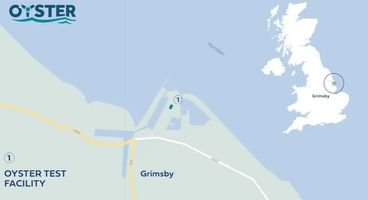EU Oyster Consortium selects Grimsby for marinised electrolyser project
Offshore wind parks will play a pivotal role to meet the EU Hydrogen Strategy target of 40 GW electrolysers by 2030.

Grimsby, a port town of North East Lincolnshire in the UK, has been selected for an innovative marinised electrolyser project for renewable hydrogen production. The project will also investigate the potential of using pipelines to transport hydrogen to shore.
What is the EU Oyster Consortium project?
The Oyster project is composed of ITM Power, Orsted, Siemens Gamesa Renewable Energy, and Element Energy. It aims to develop and test a megawatt-scale, fully marinised electrolyser in a shoreside pilot trial, which will be located in Grimsby.
The project will also explore the feasibility and potential of directly combining an offshore wind turbine with an electrolyser and transporting renewable hydrogen to shore.
The project is 100% funded by the FCH JU, which awarded € 5 million in January 2021 to the project.
Why is Grimsby ideal?
Grimsby has been selected due to its strong connection to renewable energy, in particular offshore wind. The region is home to the O&M hub for Ørsted’s UK East Coast operations, including Hornsea One and Hornsea Two, the world’s largest offshore wind farm when completed in 2022. The farms use Siemens Gamesa turbines and are fitted with blades manufactured in Hull.
The Humber is also home to Gigastack, which is developing a blueprint for deploying industrial-scale renewable hydrogen from offshore wind. The Gigastack project is led by another consortium consisting of ITM Power, Orsted, Element Energy and Phillips 66 Limited.
Demand-side dynamics in the region
The region is the UK’s largest industrial cluster by carbon dioxide emissions due to the high density of energy-intensive industries such as refineries, power stations, steelworks and glassworks
Decarbonisation of the Humber is vital for the UK’s legally binding net-zero 2050 target and the future economy of the Humber, and renewable hydrogen coupled with offshore wind could play a central role in achieving this ambition.
Technology in the Oyster project
The project will use compact electrolysis systems to withstand harsh offshore environments and have minimal maintenance requirements. The compact electrolyser system will be integrated with a single offshore wind turbine and to follow the turbine’s production profile. Furthermore, the electrolyser system will integrate desalination and water treatment processes, making it possible to use seawater as a feedstock for the electrolysis process.
Partners responsibilities
- ITM Power is responsible for the development of the electrolyser system and the electrolyser trials
- Orsted will lead the offshore deployment analysis, the feasibility study of future physical offshore electrolyser deployments, and support ITM Power in designing the electrolyser system for marinisation and testing.
- Siemens Gamesa Renewable Energy and Element Energy are providing technical and project management expertise.
Dr Graham Cooley, CEO of ITM Power, said, “Utilising offshore wind energy, and generating renewable hydrogen using water in the process of electrolysis, offers a route to decarbonise the entire energy system.”
Duncan Clark, Head of UK Region for Ørsted, said, “Just as with scaling-up offshore wind, early lessons from projects like this can then be deployed across the region and around the world.”
Michael Dolman, Partner at Element Energy, said, “Since supporting the formation of the OYSTER project, we’ve seen a growing number of projects planning offshore hydrogen production and increasing interest in this area from a wide range of stakeholders.”
Bart Biebuyck, Executive Director, Fuel Cells and Hydrogen Joint Undertaking (FCH JU), said, “Depending on local conditions it may be optimal to move the electrolysers offshore and transport hydrogen rather than electricity to shore.”
